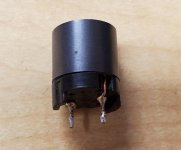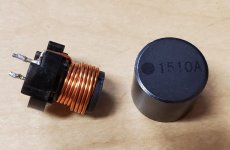Hi all,
I've been harvesting components from dead electronics, building up a box of goodies for the time when I'll need something to build my first x-over, or a BSC circuit, or whatever.
Today, I pulled apart a busted Samsung digital amp.
It had a bunch of these things in it. I assumed they were ferrite-shielded inductors.
I put one on my DATS V3 box, to see if I could get the value for it, and it says it's not an inductor.
Ok...so what is it then?
EDIT: I considered that maybe it was just faulty, since a direct measurement with my DMM returns about 0.6ohms, so I test all of them. Every one reads about the same; right around 0.5-0.7ohms.
Now I'm really confused... are they all equally shorted, or ???
I've been harvesting components from dead electronics, building up a box of goodies for the time when I'll need something to build my first x-over, or a BSC circuit, or whatever.
Today, I pulled apart a busted Samsung digital amp.
It had a bunch of these things in it. I assumed they were ferrite-shielded inductors.
I put one on my DATS V3 box, to see if I could get the value for it, and it says it's not an inductor.
Ok...so what is it then?
EDIT: I considered that maybe it was just faulty, since a direct measurement with my DMM returns about 0.6ohms, so I test all of them. Every one reads about the same; right around 0.5-0.7ohms.
Now I'm really confused... are they all equally shorted, or ???
Attachments
Last edited:
SHorted??? Look at it, it is a coil of wire, of course it will read "shorted. A piece of wire that long won't have much resistance.
I don't know what your L-meter can measure, but it is an inductor.
I don't know what your L-meter can measure, but it is an inductor.
Send me the inductor(s) and I will measure them with actual inductance meters. Include return postage if you want the inductor(s) back. PM for address ... San Francisco bay area of California.
"build my first x-over, or a BSC circuit, or whatever."
BZT wrong.
Not with a tiny electronics inductor used for low power filtering your not.
Go have a look at inductors used for speaker crossovers.
Tell me what differences you see.
BZT wrong.
Not with a tiny electronics inductor used for low power filtering your not.
Go have a look at inductors used for speaker crossovers.
Tell me what differences you see.
Thanks for the replies folks!
I suspect it is indeed exactly what davidsrsb says, and the value is simply too low for my equipment to read.
I wonder if they were using them for RF/EMF filtering or something?
Do these have any practical use for loudspeaker design purposes, or should I toss them?
I suspect it is indeed exactly what davidsrsb says, and the value is simply too low for my equipment to read.
I wonder if they were using them for RF/EMF filtering or something?
Do these have any practical use for loudspeaker design purposes, or should I toss them?
Here is an example circuit using a choke like yours. An SMD one though.
It is pretty easy to see that it is a switched mode three terminal regulator.
I did look the 5 pin chip up on an SMD markings web site and there is even a data sheet on line for it.
The choke is 2.2mh with a three digit value.
Yours looks like 1.5mh with a four digit value.
It may have been worth reverse engineering the circuit as these things run a lot cooler than the linear three terminal regulators that remain popular.
It is pretty easy to see that it is a switched mode three terminal regulator.
I did look the 5 pin chip up on an SMD markings web site and there is even a data sheet on line for it.
The choke is 2.2mh with a three digit value.
Yours looks like 1.5mh with a four digit value.
It may have been worth reverse engineering the circuit as these things run a lot cooler than the linear three terminal regulators that remain popular.
Attachments
A typical classD output inductor is in the region 10-22uH. So my guess is its 15uH. The DCR won't be what you saw on your DMM, that was most likely the lead resistance. It'll be sub-100mohm in reality.
That makes sense. I figured that was just from my test leads.
Got any use for a handful of these? 🙂
Got any use for a handful of these? 🙂
It has a coil of wire so is either an inductor or a relay.
Cant see any contacts so must be a inductor.
I suspect the inductance is sub 47uH so some meters might not go that low.
Cant see any contacts so must be a inductor.
I suspect the inductance is sub 47uH so some meters might not go that low.
You can easily see an H section cylindrical ferrite core arou d which wire is wound.
Your loudspeaker meter (actually a very crude measurement jig or adaptor) is meant for measuring TS parameters of speakers, so expects 8 ohmish impedances and below 100Hz frequencies; those inductors are designed for, say, 60 to 120 kHz duty, the TS meter won´t even "see" them.
You may keep them and in the future build a small Class D amp, use them as output inductors.
Or a small SMPS buck converter.
Your loudspeaker meter (actually a very crude measurement jig or adaptor) is meant for measuring TS parameters of speakers, so expects 8 ohmish impedances and below 100Hz frequencies; those inductors are designed for, say, 60 to 120 kHz duty, the TS meter won´t even "see" them.
You may keep them and in the future build a small Class D amp, use them as output inductors.
Or a small SMPS buck converter.
- Home
- Design & Build
- Parts
- Not an inductor?!


